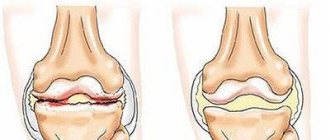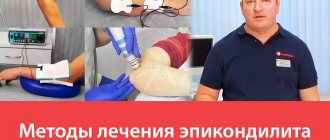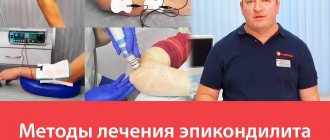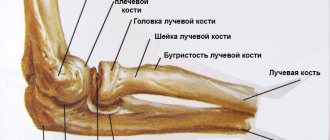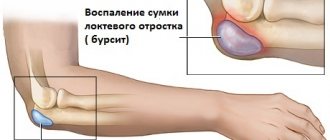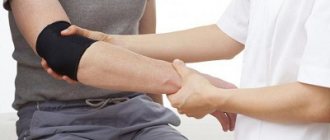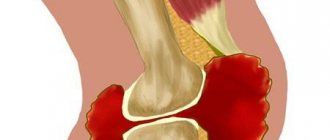In our clinic you can receive effective treatment and rehabilitation for lateral epicondylitis.
For more detailed information and to schedule a consultation, call us by phone.
Lateral epicondylitis (LE) is a chronic inflammatory and degenerative disease characterized by pain. It refers to entensopathies - pathologies that occur at the attachment points of muscle tendons and fascial ligaments to the bone). Translated from Latin, epicondylitis means inflammation of the epicondyle, that is, the protruding part of the humerus to which tendons and ligaments are attached. This bone has two of them - external (lateral) and internal (medial). It occurs more often (in 95% of cases) in the external area and is called “tennis elbow”, since it most often affects athletes who play tennis, table tennis and badminton. Inflammation in the area of the internal epicondyle occurs much less frequently and is called golfer's elbow. Also typical for wrestlers and weightlifters. Nowadays, in addition to athletes, people who work at a computer for a long time often suffer, including due to improper sitting at the workplace.
Key points:
- It is the most common disease for pain in the elbow on the outside.
- It is equally common in men and women aged 30-50 years.
- Diagnosis is most often clinical; ultrasound examination is used to confirm the diagnosis.
- The treatment plan depends on the symptoms, their severity and the stage of the pathology. Surgical intervention is indicated only for patients who have had unsuccessful experience with conservative treatment.
Lateral epicondylitis causes pain and functional limitations due to degenerative changes in the muscle tendon fibers (tendinopathy) of the forearm extensors. It usually occurs in middle-aged people and most often affects the dominant hand. Despite the many treatment options available, there is no single treatment model that will help everyone.
Tenosynovitis
Tenosynovitis is an inflammation of the tendon and its surrounding membranes, also known as synovial membranes.
Some tendons are covered with synovial membranes, but some tendons are not covered. The synovium produces a small amount of oily fluid that is secreted into the space between the tendon and its synovium. This oily fluid helps the tendon move easily and without resistance when the bone to which the tendon is attached moves. Common signs of tenosynovitis are pain, swelling and tenderness in the joint area. In most cases, it is necessary to sharply reduce movement in the inflamed joint to allow for faster recovery. Often, the pain lasts for several days and disappears without any treatment. But in other cases, pain and swelling persist for many months, especially if no treatment is given.
Any tendon in the human body can be susceptible to tenosynovitis, but there are certain areas that are most susceptible to this pathology. For example, the hand and wrist, since they are often used to perform the same type of repetitive movements.
While there is no actual evidence to suggest what exactly can prevent tenosynovitis from occurring, it is still recommended to avoid repetitive movements as much as possible. Nowadays, there are certain exercises to strengthen the muscles surrounding the damaged tendons.
What happens if the disease is not treated
Without proper treatment, tendonitis can cause tendon rupture. This is already a serious problem: to solve it, surgical intervention is often necessary.
If irritation and inflammation of the tendon continues for several weeks or months, tendinosis may develop (the tendon itself is destroyed, as well as the growth of new pathological vessels).
Tendonitis
Inflammation of the tendon is called tendonitis. This is a general term that refers to damage to a tendon, the fibrous tissue that attaches muscles to bones. The term tendonitis applies to all tendons in the body. For example, “tennis elbow” (inflammation in the elbow area), patellar tendonitis (inflammation of the tendon in the knee area), Achilles tendonitis (inflammation of the Achilles tendon), etc.
Tendonitis can occur in people of all ages, predominantly in the extremities, both upper and lower. The time required for recovery varies and depends on the degree of damage to the tendon. The inflammation usually affects the upper and lower extremities, but may occur in the shoulder or fingers.
Mainly, tendonitis occurs from repetitive movements and after physical activity (sports). Stiffness and pain are often intense, especially during and after exercise, as exercise increases inflammation in a tendon already damaged by repetitive motion. Standard treatment is usually aimed at immobilization and cold on the area of inflammation, often without identifying the causes of the disease. Early treatment helps avoid chronicity of the process.
Clarifying the diagnosis
Doctor's help should be immediate
To diagnose tendinitis, the patient is referred to:
- examination of valgus tension;
- checking hyperflexion;
- varus tension testing;
- assessment of compression syndrome;
- study of supination tension.
If the doctor deems it necessary, he may refer the patient for an X-ray, CT scan or MRI.
Causes of tendonitis
Typical tendonitis is caused by excessive stress on the tendon through repetitive movements against resistance (racquet play, jumping). Although the body tries to compensate for tendon tears, regeneration does not keep up with ongoing stress. Consequently, layering of loads increases trauma and increases pain.
With age, the elasticity of tendons decreases. In addition, concomitant diseases (such as diabetes, rheumatoid arthritis, tuberculosis) also reduce the strength and elasticity of the tendons.
Tendonitis causes inflammation of the tendon and can also be associated with the nature of the job (work as a mechanic or mechanic).
Athletes are most at risk of developing tendonitis, since there are quite a lot of repetitive movements in this type of activity.
Baseball players often throw baseballs, which can cause injuries to the wrists and shoulders. Golfers may have tendonitis in their knuckles. Basketball players who have to jump frequently are susceptible to patellar tendonitis and Achilles tendonitis. But not only excessive loads can cause tendonitis. The main thing is the presence of a large number of repetitive movements. Therefore, tendonitis can occur in artists and musicians.
Clinical diagnosis
- The pain is localized in the anterior or external aspect of the lateral epicondyle. It usually radiates along the wrist extensor muscles. May vary in frequency and strength. Discomfort increases with wrist movement and finger extension.
- The range of motion is rarely limited, but in later stages the pain increases with elbow extension and hand pronation.
- Weakness of grip is also an additional symptom.
- Special orthopedic tests are performed by an orthopedic traumatologist to confirm the diagnosis.
Diagnosis involves performing various measures (depending on the stage and complexity of epicondylitis). In particular:
- Consultation and examination with a doctor, analysis of complaints, performance of tests.
- To exclude third-party diseases, radiography is performed, which determines the presence of calcium deposits near the epicondyle.
- Ultrasound examination - visualizes the size and exact location of the ligaments.
- MRI (magnetic resonance imaging) - helps to examine inflamed areas and determine the localization of the process.
- Consultation with a neurologist, electromyography.
Symptoms of tendonitis
Signs of tendonitis may appear immediately or develop gradually. Characteristic is the presence of pain, which can be mild, aching or burning and radiating to the nearest muscles, ligaments, and bones.
Symptoms such as stiffness may also appear, as movement is impaired due to damage. Sometimes the joint does not bend. It is also possible that swelling and pain will occur in the area of the damaged tendon. Various sounds may occur when the joint moves.
Symptoms of tendonitis vary and depend on the joint involved. People with patellar tendonitis have difficulty walking up and down stairs. They also have a hard time walking long distances. While patients with tennis elbow have difficulty grasping a doorknob to open or close a door, eating food also becomes more difficult because they are unable to hold a spoon, fork, or cup properly.
If symptoms such as redness, swelling, fever, or deformation in the joint area appear, it is recommended to consult a doctor immediately. Often such symptoms indicate chronic tendonitis. Chronic tendonitis is a source of constant pain that interferes with a normal lifestyle (performing normal housework). Consultation with a doctor is necessary in order to avoid irreversible changes if the tendon is damaged.
Epicondylitis of the elbow joint: symptoms and treatment
Epicondylitis of the elbow is a condition caused by swelling of the tendons. It is accompanied by acute pain and makes it impossible to move the arm freely.
These tendons are bands of tough tissue that connect the muscles in the lower arm to the bone. This is the most common reason why people go to the doctor with painful forearm symptoms. The disease can appear in people of any age, but most often occurs around the age of 40.
We will talk about what causes inflammation, how this disease is diagnosed and treated, in this article.
Medial epicondylitis: signs
Medial epicondylitis (golfer's elbow) is a type of tendinitis that affects the inside of the elbow. The disease develops where the tendons in the forearm muscle connect to the bony part on the inside of the elbow.
Tendons attach muscles to bones. Due to injury or irritation, they may become swollen and painful.
Although medial epicondylitis is called golfer's elbow, it does not only affect golfers. This can occur from any activity that involves using the hands or wrists, including tennis and baseball. It got its name because it is in this sport that the greatest stress is placed on the inside of the elbow.
Medial epicondylitis is much less common than lateral epicondylitis (tennis elbow), with the former accounting for only 9 to 20% of all epicondylitis diagnoses. Golfer's elbow occurs as a result of the high-energy tension created by an overhead shot. In sports, this phenomenon occurs frequently in tennis, bowling, archery, weightlifting, javelin throwing, racquetball and American football.
However, from 90 to 95% of all cases, the disease is not associated with sports training.
Because chronic repetitive contractile loading of the carpi flexor and pronator muscles is the most common etiology, occupations such as carpentry, plumbing, and butchering may also cause inflammation. The pathology can also be caused by sudden tension in these tendons.
In many cases, an injury at work is the cause of symptoms.
More specific occupational factors associated with medial epicondylitis are forceful activities in men and repetitive hand movements in women. Smokers and people with type 2 diabetes are at risk.
Medial epicondylitis may occur suddenly or develop slowly over a period of time. Symptoms can range from mild to severe.
The person experiences the following symptoms:
- pain inside the elbow;
- elbow stiffness;
- weakness of the hands and wrists;
- tingling sensation or numbness in the fingers, especially the ring and little fingers;
- difficulty moving the elbow.
It is not uncommon for pain in the elbow to radiate down the arm to the wrist. This makes it difficult to perform everyday activities such as picking up objects, opening a door, or shaking hands. Typically, medial epicondylitis affects the dominant hand.
Symptoms in both tennis and golfer's elbow usually begin gradually and get worse over time.
The condition can be caused by excessive force used to bend the wrist toward the palm.
During professional activities (playing tennis, baseball), this can happen when swinging a stick or bat.
Other possible causes include:
- undeveloped playing technique;
- weak shoulder and wrist muscles;
- sudden lifting of a suitcase (any load);
- Using a tennis racket that is too heavy or too short.
Despite the “sports” name, tendon inflammation can occur in any person when performing everyday tasks: carrying heavy or bulky objects, throwing a projectile, chopping wood, operating a chain saw.
What are the causes of medial epicondylitis?
Medial epicondylitis is caused by repetitive movements, which is why the condition is most common in athletes.
Golfers can develop this type of tendonitis from repeatedly swinging a golf club, while tennis players can develop it from repeatedly using their arms to swing a tennis racket. In both cases, overuse of the hands and wrists damages the tendons and causes pain, stiffness and weakness.
Other risk factors for this type of inflammation include playing baseball or softball, rowing, and weightlifting. Activities such as playing an instrument and typing on a computer can also lead to pathology.
Symptoms of this disease are similar but occur on the inside of the arm and include:
- pain inside the elbow;
- discomfort spreads down the arm from inside the elbow;
- weakness in the hand or wrist;
- numbness or tingling in the little fingers
- pain when gripping and bending the wrist.
Most cases of golfer's elbow are not caused by inflammation. Rather, it is a problem in the tendon cells. With increased cell release and calcification, the tendons begin to lose their elasticity (collagen loses its strength). This leads to tendon fragility and ruptures.
Improper technique while playing can cause damage
Every time collagen breaks down, the body reacts by forming scar tissue into the tendon. Over time, the tendon thickens with excess scar tissue. The tendon varies from a white, shiny and hard surface to a dull, slightly brown and soft surface.
Since the medial epicondylitis is a flexor group tendon attached to the humerus, the most sensitive area will be located near the origin of the carpi flexor group.
Lateral epicondylitis: what is the cause?
Tennis elbow (lateral epicondylitis) is a painful condition that occurs when the tendons in the elbow are overused. This usually occurs due to overload and frequent repetition of the same movement.
Despite the name, athletes are not the only ones who can experience this pathology. People whose profession involves working with their hands (carpenters, plumbers, builders) often turn to doctors with a similar problem. The pain occurs primarily where the forearm muscle tendons attach to the bony lump on the outside of the elbow. The pain may also spread to the forearm and wrist.
The following symptoms are typical for this condition:
- sharp or aching pain in the elbow;
- discomfort during a handshake;
- problems with grasping an object.
With severe inflammation of the elbow joint, the patient may experience pain from holding a coffee cup in his hand or when turning a doorknob.
This condition indicates that you should consult a doctor immediately.
Rest and over-the-counter pain relievers help relieve the condition, but do not cure it. If the conservative method does not help, the doctor may suggest surgery.
Risk factors
- Age. People aged 30 to 50 years most often turn to a specialist with a similar problem.
- Professional activity. People who have jobs that involve repetitive movements of the wrist and hand are more likely to develop this condition. Examples include plumbers, painters, carpenters, butchers and chefs.
- Certain sports. Participation in racquet sports increases the risk of tennis elbow, especially if the person has poor hitting technique.
Diagnosis and treatment
Fortunately, in most cases, both types of elbow inflammation respond well to conservative treatment.
Surgery is usually not required, although full recovery may take weeks or even months, depending on the severity of the condition. As with other forms of tendinitis, the most important aspect of treatment is to reduce the stress on the affected tendons. This may include resting the arm, using a brace or a tourniquet.
After recovery, it is mandatory for athletes to correct incorrect technique to prevent recurrence of the injury.
If elbow pain does not go away within 2-3 days, you should immediately consult a doctor.
The specialist will ask questions about your symptoms, pain level, medical history, and any recent injuries. During the consultation, you should provide information about daily activities, including work responsibilities, hobbies, and recreational activities.
The doctor performs a standard external examination, which may include applying pressure to the elbow, wrist, and fingers to check for stiffness or discomfort.
Before diagnosing medial epicondylitis, your doctor may order x-rays of the inside of your elbow, arm, or wrist to rule out other possible causes of pain, such as a fracture or arthritis.
When making a diagnosis, a specialist takes into account many factors: professional, household, degree of pain and development of the disease. If there was a history of injury to the shoulder or elbow, it is necessary to mention this. There are cases when inflammation appears several months after the tendon is damaged.
You should also tell your doctor if you have a history of rheumatoid arthritis or nerve disease. These factors will help to correctly diagnose the disease and prescribe a competent course of therapy.
During the examination, the doctor uses various tests to accurately determine the diagnosis. For example, the specialist may ask to straighten the wrist and fingers against resistance while keeping the arm fully extended to see if this causes pain.
If the reaction is positive, the specialist can determine muscle damage.
To rule out the possibility of another diagnosis, your doctor may recommend additional tests:
- X-rays. These tests provide clear images of dense structures such as bones. This test can help rule out elbow arthritis.
- Magnetic resonance imaging (MRI). If your specialist suspects your symptoms are related to a neck problem, an MRI may be ordered. Tomography shows details of soft tissues and helps determine the presence of a herniated disc or arthritis in the neck. Both of these factors can cause pain.
- Electromyography (EMG). The analysis helps to exclude compression of the nerve. Many nerves are concentrated around the elbow, and the symptoms of nerve compression are similar.
Given the painful symptoms, this disease requires immediate diagnosis and treatment.
Delayed therapy can cause a chronic condition. In this case, the slightest injury or careless movement of the shoulder joint may return the painful condition in the future.
Treatment of the elbow joint
Doctors classify two types of therapy for epicondylitis: surgical and conservative.
Approximately 80% to 95% of patients are treated successfully with non-surgical methods.
- The first priority is to rest your hand. This means that it is necessary to completely stop participating in training, competitions, and put off hard work for several weeks.
- Anti-inflammatory drugs. These medications reduce pain and swelling.
- Physiotherapy. Specific exercises are useful for strengthening the forearm muscles. The therapist may also perform ultrasound, ice massage, or muscle stimulating techniques to promote muscle healing. The technique is prescribed after a complete examination and diagnosis of the degree of inflammation of the joints.
- Using a bandage. The bandage is applied to the center of the back of the forearm. This method helps to immobilize the hand, giving the necessary rest, and significantly relieves pain.
- Steroid injections. Steroids such as cortisone are very effective anti-inflammatory agents. A specialist may prescribe a course of such injections to relieve pain.
- Extracorporeal shock wave therapy. Shockwave therapy sends sound waves into the elbow, where they create a “microtrauma.” This promotes the body's natural healing processes. Shock wave therapy is still considered experimental, but today studies show its effectiveness.
Also, if you are injured during sports games or training, prevention is important. A specialist may advise checking the equipment to ensure it fits correctly in your hand.
Stiffer racquets and more flexible racquets can often reduce the stress on the forearm. If you are using the wrong size racquet, switching to a smaller head size may help prevent symptoms from recurring.
Treatment methods for epicondylitis:
Surgical intervention
1. Open surgery (excision of the area)
2. Arthroscopic surgery (through a puncture)
Non-surgical therapy
Drug treatment
2. Physiotherapy
3. Massage
4. Physical therapy
Surgery
If painful symptoms do not go away after 6-12 months of general therapy, the doctor may give a referral for surgery.
Most surgical procedures for epicondylitis involve removing the affected muscle and rebuilding the healthy muscle back to the bone.
The correct surgical approach depends on a number of factors:
- extent of injury;
- previous therapy;
- state;
- activity.
Before surgery, you should consider all possible risks associated with surgery and evaluate the need for such treatment.
Surgical intervention can take two forms: open and superficial.
The most common approach to tendon repair is open surgery. The operation involves an incision above the elbow.
The open method is usually performed quickly and does not require long-term rehabilitation. The patient does not even need an overnight hospital stay.
Arthroscopic surgery.
Inflammation can also be treated using miniature instruments and small incisions. Like open surgery, it is a one-day or outpatient procedure.
This therapy has recently gained great popularity as it minimizes the risk of surgery and does not require long recovery.
The surgeon will mark the elbow joint before the procedure. To do this, the patient's elbow is bent at an angle of 90 degrees.
The procedure is performed using two methods: in supination or pronation position.
In the first case, the patient lies on his back, and the arm is moved to the side. In the pronation position, the patient lies on his stomach, the hand is fixed in a special way through a suspension device. The operation is performed on the elbow joint, bent at a 90-degree angle.
A tourniquet is pulled onto the upper forearm with a maximum pressure of 250 mmHg. The first stage involves filling the joint with a special saline solution through a lateral approach. This allows the nerve fibers to be displaced to prevent damage. Next, the surgeon carefully inserts the needle into the muscle of the joint capsule.
Possible risks:
- infection;
- loss of strength;
- loss of flexibility;
- long recovery;
- damage to nerves and blood vessels;
- need for further surgery
Postoperative rehabilitation
After the intervention, it is very important to immobilize the arm so that there is no load on it at all. The specialist applies a splint, which is removed after 6-7 days.
The specialist shows a special training for stretching the elbow and restoring flexibility. Light exercises with gradual strengthening begin 2 months after surgery.
Returning to professional activities and sports training is an individual matter. And in each individual case, the expert gives his recommendations, depending on the type of operation, the severity of inflammation and the effect of rehabilitation. This is usually 4 to 6 months after surgery. Tennis elbow surgery is considered successful in 80-90% of patients.
Treatment with folk remedies
Alternative treatment allows you to relieve pain symptoms and relieve the main tension from the tendons. However, none of the methods is a panacea and if symptoms recur, you should consult a doctor for professional medical treatment.
- Ice – Depending on the severity of the tendinitis, icing the affected area may help reduce pain and inflammation. Ice should be applied immediately when pain flares up. A tourniquet can be used for fixation. Experts recommend doing this for 20-30 minutes every 3-4 hours for 2-3 days or until the pain goes away.
- Anti-inflammatory drugs (Ibuprofen, Naproxen) are recommended in the early stages of inflammation. They help reduce discomfort, but do not cure the problem.
- Stretching exercises – Exercises that stretch the involved forearm muscles can help relieve stress on sore tendons.
- Using an elbow strap to protect the injured tendon from further stress.
- Massage. Any manual procedures can be performed only after acute inflammation has been relieved, otherwise any pressure may aggravate the situation. A competent massage helps restore tendons, helps strengthen muscle tissue, and prevents atrophy.
Manual therapy
- The use of compresses to relieve swelling and inflammation. This ointment-based compress can be easily prepared at home. An effective method is a blue clay compress (the powder is diluted in a 1:1 ratio with warm water).
An application of ointment based on horse sorrel root and vodka shows good effectiveness.
In case of severe pain, doctors recommend applying a compress with camphor alcohol or vodka. This method helps relieve swelling and inflammation.
For minor tendinitis, you can do an iodine grid and rest your arm.
Conclusion
Symptoms for both tennis and golfer's elbow usually begin gradually and get worse over time.
Both conditions are types of tendonitis, or inflammation of the tendon, and both are usually caused by excessive repetition of the same movement. This may occur due to overuse on a regular basis (such as hitting a golf or tennis ball) or other repetitive activities that use the forearm muscles.
Over time, tendons can go from inflamed to ruptured. Therefore, when primary symptoms appear, it is important to immediately seek medical help.
Treatment of tendonitis and tendovaginitis
Currently, there is no clear method for treating tendovaginitis or tendonitis . The set of recommended measures is as follows.
- Peace. It is necessary to limit movement in the limb with damaged tendon. For this purpose, various types of orthoses can be used. For example, fixing the hand with an orthosis helps to significantly reduce the load on the tendons.
- Application of cold. You can cover the damaged area with an ice pack for 10-15 minutes daily. The effect of cryotherapy is much better. Exposure to cold reduces swelling and reduces pain.
- Analgesics. Often prescribed to relieve pain and inflammation (for example, ibuprofen). However, inflammation may not be the main cause of tendonitis or tenosynovitis. However, analgesics help reduce pain. In addition, there are ointments and gels with analgesic that can be applied topically.
- Antibiotics. Necessary in case of an infectious process.
- Injections of steroids into the affected area are recommended if other treatment measures are ineffective.
- Physiotherapy. It has a good effect, reduces inflammation, stimulates regeneration.
- Autohemotherapy. In the past, it was quite often used to treat such diseases (nowadays, it is rarely used).
- Shock wave therapy. The use of a focused sound wave has a good effect by stimulating reparative processes.
- Surgical treatment is rarely used.
- Physiotherapy. It is used only after pain has decreased. Allows you to strengthen the muscles in the area of the damaged tendon.
How does pathology manifest itself?
The disease is characterized by sudden onset
In some cases, the disease takes years to develop. A typical symptom of elbow tendinitis is pain.
He can be:
- pulsating;
- sharp;
- aching.
Painful sensations occur when a person moves his arm. At night they become stronger and interfere with falling asleep.
There is a limitation of joint mobility. A crunching sound is heard while driving. The skin becomes hot and its shade changes.
